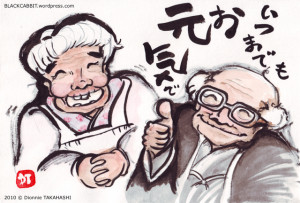Nagatsuki is the shortened form of Yonagazuki, meaning “long-night month” for what is today the month of September. Tsukimi or “Moon-viewing” parties are popular today but originally began in the Heian Era (794-1185 CE) to honor harvests and the beauty of the moon. At tsukimi celebrations, many feast on dumplings and celebrate the coming of autumn.
This month, two national holidays including Keiro no hi, or Respect for the Aged Day, and Autumnal Equinox Day are observed.
https://blackcabbit.wordpress.com/
Respect for Aged day is celebrated on the 3rd Monday in September and is one of many Japan’s national holidays. It’s a holiday that is spent respecting, honoring, and giving gifts to the elders. It highlights the longevity of Japan’s elderly population.
“With improvements in healthcare, Japanese people are living longer than ever and the number of people over the age of 100 is expected to reach 32,000 next month.
One in five Japanese are aged 65 or older and Japanese women can expect to live to see their 85th birthday.” – http://www.officeholidays.com/
Autumnal Equinox Day usually falls on Sept 22 or 23. It is a period of time where Japanese people pay respects to their ancestors, elders, and important family members. Also, it marks the day that daylight will be getting shorter as winter approach.
“The Japanese have traditionally called the period around the autumnal and vernal (springtime) equinoxes higan. There’s a saying that goes, “both the heat and cold end with higan.” Higan lasts for seven days – beginning three days prior to the equinox and ending three days after it. It occurs twice a year, once when the blustery winter temperatures give way to spring and again when the heat subsides and the cool, crisp air of autumn arrives.
Higan has Buddhist origins. It means the “other side of the river of death.” This side of the river is the world where we live, and the other side is the realm where the souls of those who have passed away dwell. To pray for the repose of deceased ancestors, visits are made to the family grave.” – http://web-japan.org/



